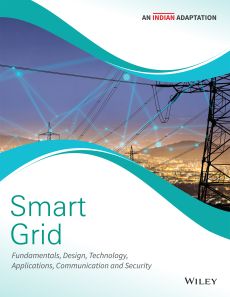Smart Grid: Fundamentals, Design, Technology, Applications, Communication and Security, An Indian Adaptation
ISBN: 9789354243219
360 pages
Publication Year: 2021
For more information write to us at: acadmktg@wiley.com

Description
Electric power systems worldwide are facing a radical change stimulated by the pressing need to de-carbonise electricity supply, replace ageing assets, and make effective use of the rapidly developing Information and Communication Technologies for better monitoring and control of power grids. In conventional grids, participation of the consumer in grid operation and control is almost nil. However, this has changed with the advent of fast communication technology and smart metering techniques, which permit consumers to participate in grid operation.
Preface to the Adapted Edition
About the Authors
Smart Grid: Applications, Communications and Security
Contributors
Chapter 1 Introduction to Smart Grid and Architectural Designs
1.1 Introduction
1.2 Why Implement the Smart Grid Now?
1.3 Conventional Grid versus the Smart Grid
1.4 What is the Smart Grid?
1.5 Smart Grid Domains
1.6 Early Smart Grid Initiatives
1.7 Overview of the Technologies Required for the Smart Grid
1.8 Energy Independence and Security Act of 2007: Rationale for the Smart Grid
1.9 Stakeholder Roles and Functions
1.10 Core Applications for Smart Grid
1.11 Voltage and VAR Control
1.12 Fault Detection, Isolation, and Restoration
1.13 Demand Response
1.14 Distributed Energy Resources
1.15 Wide-Area Monitoring, Protection, and Control
1.16 Representative Architectures for Smart Grid
1.17 Functions of Smart Grid Components
Chapter 2 Measurement and Monitoring in Smart Grid
2.1 Introduction
2.2 Intelligent Electronic Devices
2.3 Remote Terminal Units
2.4 Evolution of Smart Metering
2.5 Smart Meters
2.6 Communication Infrastructure for Smart Metering
2.7 Wide Area Monitoring, Protection, and Control (WAMPAC)
2.8 Multiagent Systems Technology
Chapter 3 Communication Technologies for Smart Grid
3.1 Introduction
3.2 Communication Technologies
3.3 Smart Grid Network Architecture
3.4 Network Layer Aspects of Smart Grid Communication
Chapter 4 Renewable Energy Sources and Storage in Smart Grid
4.1 Introduction
4.2 Sustainable Energy Options for Smart Grid
4.3 Penetration and Variability Issues Associated with Sustainable Energy Technology
4.4 Demand Response Issues
4.5 Energy Storage Technologies
4.6 Case Study: Energy Storage for Wind Power
4.7 Selection of Storage Technology
Chapter 5 Transmission and Distribution for Smart Grid
5.1 Introduction
5.2 Smart Transmission
5.3 Energy Management Systems
5.4 Wide-Area Applications
5.5 Visualisation Techniques
5.6 Substation Automation
5.7 Distribution Management Systems
5.8 Modelling and Analysis Tools
5.9 Applications for Distribution Network Automation
Chapter 6 Analysis Tools for Smart Grid
6.1 Introduction
6.2 Challenges to Load Flow in Smart Grids
6.3 Classical Load Flow Formulations
6.4 Congestion Management
6.5 Load Flow for Smart Grid Design
6.6 Contingencies and Their Classification
6.7 Stability Analysis
6.8 Existing Voltage Stability Techniques
6.9 Voltage Stability Assessment
6.10 Voltage Stability Techniques
6.11 Voltage Stability Indexing
6.12 Preventive Control for Voltage Stability
6.13 Angle Stability Assessment
6.14 State Estimation for Smart Grid
Chapter 7 Interoperability, Cyber Security, and Standards
7.1 Introduction
7.2 Interoperability
7.3 Information Security for Smart Grid
7.4 Encryption and Decryption for Security
7.5 Authentication
7.6 Digital Signatures
7.7 Cyber Security Standards
7.8 Cyber Security Risks
Chapter 8 Role of Electric Vehicles in Smart Grid
8.1 Introduction
8.2 Electric Vehicles and Hybrids
8.3 PHEV Technology
8.4 Storage Technologies for Electric Vehicles
8.5 Vehicle Architecture, Key Components, Controls, and Cost
8.6 Grid to Vehicle (G2V) Charging: Levels 1 to 3
8.7 Vehicle-to-Grid (V2G) Power
8.8 Environmental Implications
8.9 Case Study: Agent-Based Control of Electrical Vehicle Battery Charging
Chapter 9 Case Studies and Testbeds for Smart Grid
9.1 Introduction
9.2 Demonstration Projects
9.3 Microgrid with Renewable Energy
9.4 Case Study of Renewable Energy Resource (RER) Integration
9.5 Hybrid Smart Grid in Rural Greece
9.6 Network Design and Implementation in Larissa
9.7 Smart Grid Applications Offered in Larissa
9.8 Issues Related to Smart Grid Experience in Larissa
9.9 Remote Access to Home Appliances
9.10 Access Control and Authorisation for Remote Access to Home Energy Appliances
Chapter 10 Indian Smart Grid Scenario
10.1 Introduction
10.2 Indian Power Sector
10.3 Renewable Energy Development in India
10.4 Smart Grid Drivers for India
10.5 Smart Grid Initiatives in India
10.6 Roadmap
10.7 Smart Grid Pilot Projects
10.8 Case Studies
Summary
Review Questions
References
Index

